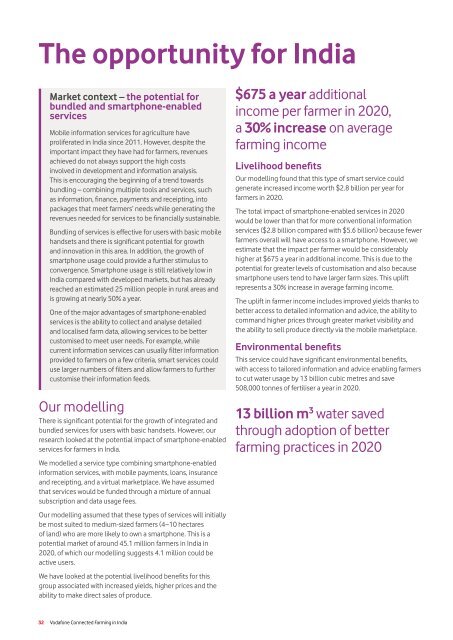Connected-Farmers
Connected-Farmers
Connected-Farmers
You also want an ePaper? Increase the reach of your titles
YUMPU automatically turns print PDFs into web optimized ePapers that Google loves.
The opportunity for India<br />
Market context – the potential for<br />
bundled and smartphone-enabled<br />
services<br />
Mobile information services for agriculture have<br />
proliferated in India since 2011. However, despite the<br />
important impact they have had for farmers, revenues<br />
achieved do not always support the high costs<br />
involved in development and information analysis.<br />
This is encouraging the beginning of a trend towards<br />
bundling – combining multiple tools and services, such<br />
as information, finance, payments and receipting, into<br />
packages that meet farmers’ needs while generating the<br />
revenues needed for services to be financially sustainable.<br />
Bundling of services is effective for users with basic mobile<br />
handsets and there is significant potential for growth<br />
and innovation in this area. In addition, the growth of<br />
smartphone usage could provide a further stimulus to<br />
convergence. Smartphone usage is still relatively low in<br />
India compared with developed markets, but has already<br />
reached an estimated 25 million people in rural areas and<br />
is growing at nearly 50% a year.<br />
One of the major advantages of smartphone-enabled<br />
services is the ability to collect and analyse detailed<br />
and localised farm data, allowing services to be better<br />
customised to meet user needs. For example, while<br />
current information services can usually filter information<br />
provided to farmers on a few criteria, smart services could<br />
use larger numbers of filters and allow farmers to further<br />
customise their information feeds.<br />
Our modelling<br />
There is significant potential for the growth of integrated and<br />
bundled services for users with basic handsets. However, our<br />
research looked at the potential impact of smartphone-enabled<br />
services for farmers in India.<br />
We modelled a service type combining smartphone-enabled<br />
information services, with mobile payments, loans, insurance<br />
and receipting, and a virtual marketplace. We have assumed<br />
that services would be funded through a mixture of annual<br />
subscription and data usage fees.<br />
$675 a year additional<br />
income per farmer in 2020,<br />
a 30% increase on average<br />
farming income<br />
Livelihood benefits<br />
Our modelling found that this type of smart service could<br />
generate increased income worth $2.8 billion per year for<br />
farmers in 2020.<br />
The total impact of smartphone-enabled services in 2020<br />
would be lower than that for more conventional information<br />
services ($2.8 billion compared with $5.6 billion) because fewer<br />
farmers overall will have access to a smartphone. However, we<br />
estimate that the impact per farmer would be considerably<br />
higher at $675 a year in additional income. This is due to the<br />
potential for greater levels of customisation and also because<br />
smartphone users tend to have larger farm sizes. This uplift<br />
represents a 30% increase in average farming income.<br />
The uplift in farmer income includes improved yields thanks to<br />
better access to detailed information and advice, the ability to<br />
command higher prices through greater market visibility and<br />
the ability to sell produce directly via the mobile marketplace.<br />
Environmental benefits<br />
This service could have significant environmental benefits,<br />
with access to tailored information and advice enabling farmers<br />
to cut water usage by 13 billion cubic metres and save<br />
508,000 tonnes of fertiliser a year in 2020.<br />
13 billion m 3 water saved<br />
through adoption of better<br />
farming practices in 2020<br />
Our modelling assumed that these types of services will initially<br />
be most suited to medium-sized farmers (4–10 hectares<br />
of land) who are more likely to own a smartphone. This is a<br />
potential market of around 45.1 million farmers in India in<br />
2020, of which our modelling suggests 4.1 million could be<br />
active users.<br />
We have looked at the potential livelihood benefits for this<br />
group associated with increased yields, higher prices and the<br />
ability to make direct sales of produce.<br />
32 Vodafone <strong>Connected</strong> Farming in India


